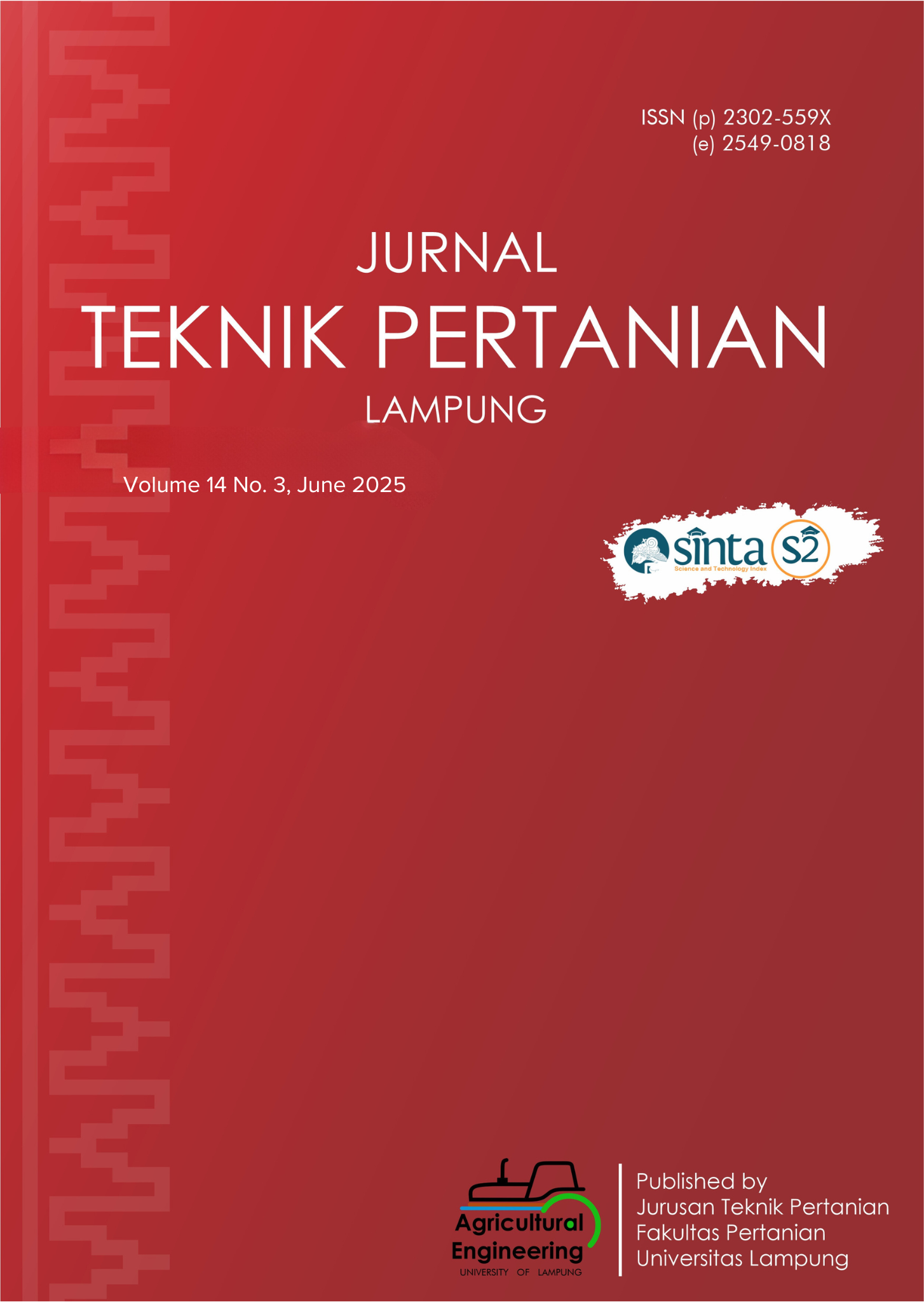Physical Properties of Extrudates Based on Corn Grit, Mocaf Flour and Gaplek Flour Using a Twin Screw Extruder with Treatment of Moisture Content and Barrel Temperature
DOI:
https://doi.org/10.23960/jtep-l.v14i3.732-743 Abstract View: 370
Abstract View: 370
Abstract
Cassava is a commodity that has not been widely innovated on. Mocaf flour and gaplek flour can be innovated as snacks using extrusion technology. This study examined the effects of varying ratios of mocaf/gaplek flour to corn grits (0% / 10% / 20%), initial moisture content (14 / 16 / 18%), and barrel temperature (120 / 130 /140°C) on the physical properties of the extrudate and to characterize the physical properties of the extrudate using PCA analysis. Physical properties such as expansion ratio, particle density, moisture content, color (L and b*), water absorption index (WAI), water solubility index (WSI), and hardness were analyzed. The extrusion process was performed using a SYSLG-IV twin screw extruder (10 15 kg/hour capacity). The addition of mocaf/gaplek flour increased particle density, moisture content, L, and hardness but decreased the expansion ratio. Initial moisture content had a negative effect on the expansion ratio, WAI, and WSI while having positive effect on particle density, moisture content, and hardness. Increasing barrel temperature decreases the expansion ratio and moisture content but increases WAI and WSI. Extrudate treated with 14% moisture content was found to have better physical properties.
Keywords: Corn grit, Extrusion, Gaplek flour, Mocaf flour, Physical properties.
Downloads
References
Adekola, K. A. (2016). Engineering Review Food Extrusion Technology and Its Applications. Journal of Food Science and Engineering, 6(3), 149–168. https://doi.org/10.17265/2159-5828/2016.03.005
Agathian, G., Semwal, A.D., & Sharma, G.K. (2015). Optimization of barrel temperature and kidney bean flour percentage based on various physical properties of extruded snacks. Journal of Food Science and Technology, 52(7), 4113–4123. https://doi.org/10.1007/s13197-014-1483-7
Altaf, U., Hussain, S. Z., Qadri, T., Iftikhar, F., Naseer, B., & Rather, A.H. (2021). Investigation on mild extrusion cooking for development of snacks using rice and chickpea flour blends. Journal of Food Science and Technology, 58(3), 1143–1155. https://doi.org/10.1007/s13197-020-04628-7
Altan, A., & Maskan, M. (2012). Development of extruded foods by utilizing food industry by-products. In Maskan, M., & Altan, A. (editors): Advances in Food Extrusion Technology, 121–168.
Berrios, J.D-J., Wood, D.F., Whitehand, L.C., & Pan, J. (2004). Sodium bicarbonate and the microstructure, expansion and color of extruded black beans. Journal of Food Processing and Preservation, 28(5), 321–335.
Bertoft, E., Laohaphatanalert, K., Piyachomkwan, K., & Sriroth, K. (2010). The fine structure of cassava starch amylopectin. Part 2:
Building block structure of clusters. International Journal of Biological Macromolecules, 47(3), 325–335. https://doi.org/10.1016/j.ijbiomac.2010.05.018
Boakye, P.G., Okyere, A., Kougblenou, I., Kowalski, R., Ismail, B.P., & Annor, G.A. (2022). Optimizing the extrusion conditions for the production of expanded intermediate wheatgrass (Thinopyrum intermedium) products. Journal of Food Science, 87(8), 3496–3512. https://doi.org/10.1111/1750-3841.16238
Chisenga, S.M., Workneh, T.S., Bultosa, G., & Alimi, B.A. (2019). Progress in research and applications of cassava flour and starch: a review. Journal of Food Science and Technology, 56(6), 2799–2813. https://doi.org/10.1007/s13197-019-03814-6
Choton, S., Gupta, N., Bandral, J.D., Anjum, N., & Choudary, A. (2020). Extrusion technology and its application in food processing: A review. Pharma Innovation, 9(2), 162–168. https://doi.org/10.22271/tpi.2020.v9.i2d.4367
Dalbhagat, C.G., Mahato, D.K., & Mishra, H.N. (2019). Effect of extrusion processing on physicochemical, functional and nutritional characteristics of rice and rice-based products: A review. Trends in Food Science and Technology, 85, 226–240. https://doi.org/10.1016/j.tifs.2019.01.001
FAOSTAT. (2022). Crops and livestock products: Cassava. https://Www.Fao.Org/Faostat/En/#data/QCL/Visualize
FAOSTAT. (2024). Crops and livestock products: Maize (Corn). https://Www.Fao.Org/Faostat/En/#data/QCL/Visualize
Fayose, F. (2013). Expansion characteristics of selected starchy crops during extrusion. West Indian Journal of Engineering, 35(2), 58–64.
Fiorda, F.A., Soares, M.S., da Silva, F.A., de Moura, C.M.A., & Grossmann, M.V.E. (2015). Physical quality of snacks and technological properties of pre-gelatinized flours formulated with cassava starch and dehydrated cassava bagasse as a function extrusion variables. LWT - Food Science and Technology, 62(2), 1112–1119. https://doi.org/10.1016/j.lwt.2015.02.030
Haryadi. (2011). Teknologi modifikasi tepung kasava. Agritech, 31(2), 86–92.
Huang, X., Liu, H., Ma, Y., Mai, S., & Li, C. (2022). Effects of extrusion on starch molecular degradation, order–disorder structural transition and digestibility—A review. Foods, 11(16), 2538. https://doi.org/10.3390/foods11162538
Kanojia, V., & Singh, M. (2016). Extruded product quality assessment indices: A review. International Journal of Agriculture Sciences, 8(54), 2928–2934.
Kantrong, H., Charunuch, C., Limsangouan, N., & Pengpinit, W. (2018). Influence of process parameters on physical properties and specific mechanical energy of healthy mushroom-rice snacks and optimization of extrusion process parameters using response surface methodology. Journal of Food Science and Technology, 55(9), 3462–3472. https://doi.org/10.1007/s13197018-3271-2
Kardhinata, E.H., Purba, E., Suryanto, D., & Rusmarilin, H. (2019). Modified cassava flour (MOCAF) content of cassava (Manihot esculenta CRANTZ) in North Sumatera. IOP Conference Series: Earth and Environmental Science, 260, 012088. https://doi.org/10.1088/1755-1315/260/1/012088
Kaur, A., Kaur, S., Singh, M., Singh, N., Shevkani, K., & Singh, B. (2015). Effect of banana flour, screw speed and temperature on extrusion of corn extrudates. Journal of Food Science and Technology, 52, 4276–4285. https://doi.org/10.1007/s13197-014-1524-2
Korkerd, S., Wanlapa, S., Puttanlek, C., Uttapap, D., & Rungsardthong, V. (2016). Expansion and functional properties of extruded snacks enriched with nutrition sources from food processing by-products. Journal of Food Science and Technology, 53, 561-570. https://doi.org/10.1007/s13197-015-2039-1
Lazou, A.E., Michailidis, P.A., Thymi, S., Krokida, M.K., & Bisharat, G.I. (2007). Structural properties of corn-legume based extrudates as a function of processing conditions and raw material characteristics. International Journal of Food Properties, 10(4), 721–738. https://doi.org/10.1080/10942910601154305
Leonel, M., de Freitas, T.S., & Mischan, M.M. (2009). Physical characteristics of extruded cassava starch. Food Science and Technology • Sci. agric. (Piracicaba, Braz.), 66(4), 486–493. https://doi.org/10.1590/S0103-90162009000400009
Mali, S., Karam, L.B., Ramos, L.P., & Grossmann, M.V.E. (2004). Relationships among the composition and physicochemical properties of starches with the characteristics of their films. Journal of gricultural and Food Chemistry, 52(25), 7720–7725. https://doi.org/10.1021/jf049225+
Marta, H., Suryadi, E., & Ruswandi, D. (2017). Chemical composition and genetics of Indonesian maize hybrids. American Journal of Food Technology, 12(2), 116–123. https://doi.org/10.3923/ajft.2017.116.123
Minweyelet, M., Solomon, W.K., & Bultosa, G. (2021). Effects of extrusion operating conditions and blend proportion on the physicochemical and sensory properties of teff-rice blend extruded products. Food Research, 5(2), 173–183. https://doi.org/10.26656/fr.2017.5(2).467
Mohammed, I., Forsido, S.F., & Kuyu, C.G. (2024). Optimization of barrel temperature and feed moisture content for better physicochemical and sensory properties of extruded snacks from blends of finger millet, sweet potato, and soybean composite flour using response surface methodology. Discover Applied Sciences, 6(183). https://doi.org/10.1007/s42452-024-05822-4
Nasir, M.A., Qori’Ah, C.G., & Wardhono, A. (2021). Measuring the competitiveness of cassava in East Java, Indonesia: Evidence in Jember regency. IOP Conference Series: Earth and Environmental Science, 759, 012049. https://doi.org/10.1088/17551315/759/1/012049
Patel, J. R., Patel, A. A., & Singh, A. K. (2016). Production of a protein-rich extruded snack base using tapioca starch, sorghum flour and casein. Journal of Food Science and Technology, 53, 71–87. https://doi.org/10.1007/s13197-015-2012-z
Pathak, N., & Kochhar, A. (2018). Extrusion Technology: Solution to Develop Quality Snacks for Malnourished Generation. International
Journal of Current Microbiology and Applied Sciences, 7(1),
–1307. https://doi.org/10.20546/ijcmas.2018.701.158
Peksa, A., Kita, A., Carbonell-Barrachina, A.A., Miedzianka, J., Kolniak-Ostek, J., Tajner-Czopek, A., Rytel, E., Siwek, A., Miarka, D., & Drozdz, W. (2016). Sensory attributes and physicochemical features of corn snacks as affected by different flour types and extrusion conditions. LWT - Food Science and Technology, 72, 26–36. https://doi.org/10.1016/j.lwt.2016.04.034
Philia, J., Widayat, W., Suzery, M., & Budianto, I. (2020). Diversifikasi tepung mocaf menjadi produk mie sehat di PT. Tepung Mocaf Solusindo. Indonesia Journal of Halal, 2(2), 40–45.
Purwadi, R., Teguh, C.F., & Mazaya, D. (2021). Fermented cassava as an alternative flour for pasta noodle. IOP Conference Series: Materials Science and Engineering, 1143, 012042. https://doi.org/10.1088/1757-899x/1143/1/012042
Putri, N.A., Herlina, H., & Subagio, A. (2018). Karakteristik mocaf (modified cassava flour) berdasarkan metode penggilingan dan lama fermentasi. Jurnal Agroteknologi, 12(01), 79–89. https://doi.org/10.19184/j-agt.v12i1.8252
Seth, D., Badwaik, L.S., & Ganapathy, V. (2015). Effect of feed composition, moisture content and extrusion temperature on extrudate characteristics of yam-corn-rice based snack food. Journal of Food Science and Technology, 52, 1830–1838. https://doi.org/10.1007/s13197-013-1181-x
Sharifi, S., Majzoobi, M., & Farahnaky, A. (2021). Effects of particle size and moisture content of maize grits on physical properties of expanded snacks. Journal of Texture Studies, 52(1), 110–123.
Sharma, C., Singh, B., Hussain, S.Z., & Sharma, S. (2017). Investigation of process and product parameters for physicochemical properties of rice and mung bean (Vigna radiata) flour based extruded snacks. Journal of Food Science and Technology, 54(6), 1711–1720. https://doi.org/10.1007/s13197-017-2606-8
Shirazi, S.L., Koocheki, A., Milani, E., & Mohebbi, M. (2020). Production of high fiber ready-to-eat expanded snack from barley flour and carrot pomace using extrusion cooking technology. Journal of Food Science and Technology, 57, 2169–2181. https://doi.org/10.1007/s13197-020-04252-5
Statista. (2023). Snack Food - Indonesia. https://Www.Statista.Com/Outlook/Cmo/Food/Confectionery-snacks/SnackFood/Indonesia (Accessed 01 August 2024)
Sudhakar, A., Dash, S.K., Bal, L.M., Sahoo, N.R., & Rayaguru, K. (2021). Extrudate snacks from rice flour and oyster mushroom powder: Physico-chemical and functional properties characterization and storability evaluation. Journal of the Indian Chemical Society, 98(10), 100160. https://doi.org/10.1016/j.jics.2021.100160
Tatsabong, L.T., & Ryu, G-H. (2018). The effect of corn flour addition on the physico-chemical properties of extruded cassava starch. Food Engineering Progress, 22(3), 220–227. https://doi.org/10.13050/foodengprog.2018.22.3.220
Tumwine, G., & Asiimwe, A. (2019). Effect of barrel temperature and blending ratio on the sensory and physical properties of cassava-extruded snacks. Cogent Food & Agriculture, 5(1), 1633795. https://doi.org/10.1080/23311932.2019.1633795
Vatanparast, H., Islam, N., Masoodi, H., Shafiee, M., Patil, R.P., Smith, J., & Whiting, S.J. (2020). Time, location and frequency of snack consumption in different age groups of Canadians. Nutrition Journal, 19, 85. https://doi.org/10.1186/s12937-02000600-5
Yu, J-K., & Moon, Y-S. (2022). Corn starch: Quality and quantity improvement for industrial uses. Plants, 11(1), 92. https://doi.org/10.3390/plants11010092
Zambrano, Y., Contardo, I., Moreno, M.C., & Bouchon, P. (2022). Effect of extrusion temperature and feed moisture content on the microstructural properties of rice-flour pellets and their impact on the expanded product. Foods, 11(2), 198. https://doi.org/10.3390/foods11020198
Zhu, F. (2015). Composition, structure, physicochemical properties, and modifications of cassava starch. Carbohydrate Polymers, 122, 456–480. https://doi.org/10.1016/j.carbpol.2014.10.063
Downloads
Published
How to Cite
Issue
Section
License
Authors who publish with this journal agree to the following terms:
Authors retain copyright and grant the journal right of first publication with the work simultaneously licensed under a Creative Commons Attribution-ShareAlike 4.0 International Lice that allows others to share the work with an acknowledgement of the work's authorship and initial publication in this journal.
Authors are able to enter into separate, additional contractual arrangements for the non-exclusive distribution of the journal's published version of the work (e.g., post it to an institutional repository or publish it in a book), with an acknowledgement of its initial publication in this journal.
Authors are permitted and encouraged to post their work online (e.g., in institutional repositories or on their website) prior to and during the submission process, as it can lead to productive exchanges, as well as earlier and greater citation of published work (See The Effect of Open Access).
Jurnal Teknik Pertanian Lampung

JTEPL is licensed under a Creative Commons Attribution-ShareAlike 4.0 International License.













